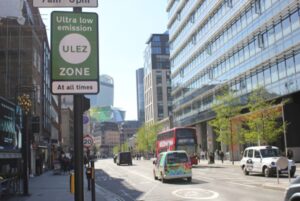Discover what’s causing air pollution in London with this interactive map
Environmental Defense Fund Europe has been working on a new Greater London map that displays detailed information on the sources of health-harming air pollution. Search for or click anywhere on the map to get a breakdown of pollution sources – for both nitrogen oxides (NOx) and fine particulate matter (PM2.5) pollution – at that particular spot.
What does the map display?
The map uses data produced by Cambridge Environmental Research Consultants (CERC) using the ADMS-Urban model as part of the Breathe London pilot project.
Based on modelled data for 2019, the map:
- Displays an estimate of annual average NOx and PM5 pollution levels in London for major different sources of pollution.
- Allows users to see a calculation of the pollution that people breathe, depending on where they are in the city and separated out by source category.
- Provides distinct visual ‘layers’ for more than 20 individual sources (e.g., taxis, Transport for London buses, commercial gas), as well as grouped sources (e.g., all diesel vehicles).
The modelled data, which takes into account factors like wind and weather, is available on a 10 metre grid across London and provides the annual pollution concentrations experienced at 1m above ground level.

Which sources are included?
- Road transport: Cars, buses, lorries, etc. and particularly those that run on diesel fuel.
- Other transport: Other means of transportation that don’t involve the road, such as planes, trains and ships.
- Commercial and domestic fuel: Heating and powering of indoor spaces like our homes, offices and shops by combustion of fuels such as gas, oil and wood.
- Industrial and construction: Waste management activities like energy from waste plants and ‘Non-Road Mobile Machinery,’ i.e., construction sites and machines like diggers, excavators and diesel generators.
- Miscellaneous: Other smaller sources like sewage treatment and smaller household sources
- Background: Pollution produced outside of London that has been blown in by the wind.
Pollution health impacts
The map displays two pollutants: NOx and PM2.5. NOx are a sum of nitric oxide (NO) and nitrogen dioxide (NO2) which, along with PM2.5, are the main air pollutants of concern in London. They are harmful to human health and are associated with adverse health outcomes like asthma, strokes and cancer.
London also has emissions inventories for NOx and PM2.5, meaning there is a detailed list of all the activities contributing to these pollutants across the city. The model that is behind the dataset requires these emission inventories.
This is the first time that modelled pollution sources data has been displayed in this detail across Greater London on an interactive public map. With a better understanding of which activities are causing pollution and where, leaders and communities can develop targeted solutions that clean the air and protect people’s health.
Please see here for a recorded demo on how to use the map, explain how the data was calculated and answer your questions.
















